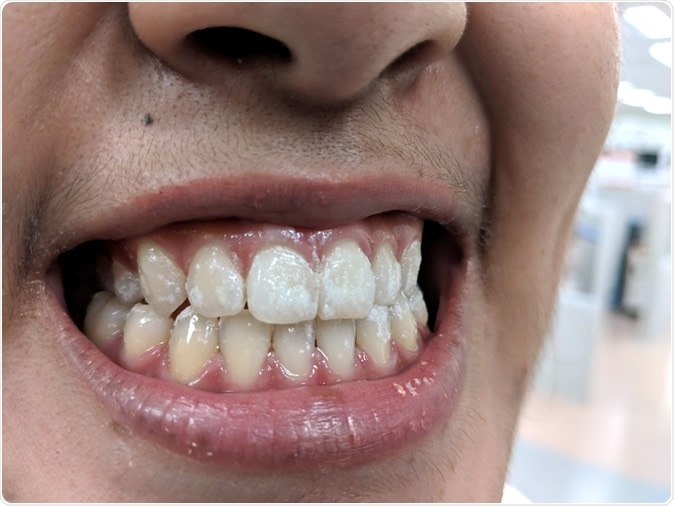Although extremely popular for preventing tooth decay in children, fluoride varnish may be nothing more than an expensive placebo, according to the results of a new study by University of Washington researchers.
Many dental care specialists as well as pediatricians have used fluoride varnish, which can be used to coat teeth like a color veneer. Once applied with a brush, it dries in a few hours protecting teeth from tooth decay. And the child will not swallow it once it dries. Almost any minimally trained person can do it.
The cost is also in its favor, about $25 to $55 a pop, much cheaper than a full dental appointment. However, the question raised by this new study is whether the treatment is even worth that investment.
The study is published in the journal Dental caries research.
Teeth with fluoride varnish. Credit: Punrit Thongma-en/Shutterstock
What did they look for?
The study is a review of 20 clinical trials covering the use of fluoride varnish in 13 countries, either as part of a dental program or as a standalone. They compared the effectiveness of fluoride varnish with that of placebo or standard care.
The population examined in this review included more than 13,600 children from preschool to 6 years of age. Areas of review included the use of fluoride varnish alone or accompanied by a dental health programme. Controls included placebo, no care, or usual care. The outcomes sought were caries (incidence of caries, number of teeth and tooth surfaces affected, and short-term as well as long-term adverse effects. Caries was assessed by the number of decayed, missing and filled teeth and surfaces.
The reviewers noted that the study population consisted primarily of children who had one or more risk factors for dental caries, who were treated with multiple fluoride treatments, including fluoridated drinking water, fluoride toothpaste, and fluoride varnish. More modern trials have targeted both high- and low-risk children.
What did they find?
The reviewers noted that the tests did not show that fluoride varnish had any protective effect. This was despite a 12% reduction in the risk of developing new cavities in this population, compared to those children who did not receive this treatment. The lack of significance is due to the large prediction interval from 0.68 to 1.14. This means that future studies may predict a 32% risk reduction or a 14% increased risk respectively with the use of fluoride varnish. They also predicted that the varnish would have to be applied to 17 children to benefit one child (with a predicted 50% caries rate in children). In their words, “This was a rather modest benefit, as a large number of children developed new dentin caries lesions regardless of fluoride varnish use.”
Reasons for the apparent lack of significant efficacy could include variations in fluoride concentrations between the different varieties used.
What are the alternatives?
More effective alternatives include sealants, which are a little more difficult to apply correctly, but are worth it since they remain active for the next 2-3 years. This is especially important for molars in the back of the mouth that are difficult to reach. The best sealants are those with glass ionomers since they release fluoride at a constant rate. Resin-based sealants also work, but do not provide fluoride.
Another form of fluoride is silver diamine fluoride which is gaining in popularity due to its high effectiveness. However, it can stain the teeth, which affects younger children less, as they will lose their baby teeth anyway. Another more serious obstacle is the lack of data on the actual preventive effectiveness of this fluoride.
Overall, reviewers favor fluoride toothpaste because of its low cost, ease of use, and daily application. Fluoride rinses are also nearly as effective at exposing teeth to fluoride each day. Fluoride varnish does not appear to be cost-saving for the maintenance of baby teeth, but may do so if used to maintain permanent teeth in a high-risk environment or if used by people other than professional dental care providers.
conclusion
The study concludes that more studies will be needed to decide whether fluoride varnish is worth its cost in various settings and applications. At present, fluoride varnish is only one of the alternatives to be presented for childhood dental prevention. And the best thing, even then, would be to stop children from eating too many sweets and sugary drinks, because many children continued to develop new cavities whether they used fluoride varnish or not.

